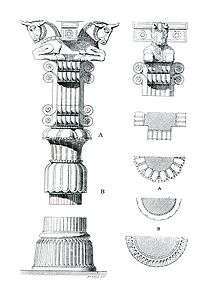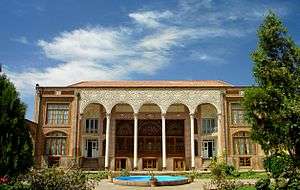Persian column

Persian columns or Persians is an archaeological term referring to columns such as those found in Persepolis with a base, fluted shaft, and double-bull capital. Some of the most elaborate columns in the ancient world were those of Persia especially the massive stone columns erected in Persepolis. They included double-bull structures in their capitals. The Hall of Hundred Columns at Persepolis, measuring 70 x 70 metres was built by the Achaemenid king Artaxerxes I. Many more Persian examples can be found throughout the rich history of Persia and its many empires, as they conquered more and more neighbouring kingdoms it took in much of the know how of many civilizations and erected different styles of pillars.
Gallery
-

Persian column
-

Persian column
-

Achaemenid example, the oldest to be found
-

Plan, Front view and side view of a typical Persepolis column, of Persia (Iran)
-

Saffavid examples found not only in Iran but also in Central Asia, Afghanistan, Pakistan and India